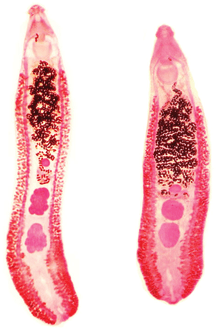Echinostoma revolutum
| Echinostoma revolutum | |
|---|---|
 | |
| two specimens of Echinostoma revolutum | |
| Scientific classification | |
| Kingdom: | Animalia |
| Phylum: | Platyhelminthes |
| Class: | Trematoda |
| Order: | Echinostomida |
| Family: | Echinostomidae |
| Genus: | Echinostoma |
| Species: | E. revolutum |
| Binomial name | |
| Echinostoma revolutum (Froelich, 1802) Looss, 1899 | |
Echinostoma revolutum is a fluke that can be a parasite in humans. It causes the disease echinostomiasis.[1]
Distribution
Echinostoma revolutum is the most widely distributed species of all 20 Echinostomatidae species and it is found from Asia and Oceania to Europe and the Americas.[1]
Echinostomiasis is not only an endemic infectious disease in Asian countries, but also can be imported by overseas travelers from the United States or Europe.[1] An outbreak of echinostomiasis was reported among US travelers returning from Kenya and Tanzania, although the source of infection was uncertain.[1]
Description
The worms are leaflike, elongated, and an average of 8.8 mm long (8.0–9.5 mm) and 1.7 mm wide (1.2–2.1 mm).[1] When first passed in the feces, they were pinkish red and coiled in a "c" or "e" shape.[1] The eggs in uteri were an average of 105 μm long (97–117 μm) and 63 μm wide (61–65 μm).[1]
Life cycle
Infection of Echinostoma revolutum usually results from ingestion of raw snails or frogs that serve as an intermediate host. This parasite is predominantly found throughout North America. Two asexual generations occur in a snail or mollusk. The first snail host is penetrated by a miracidium, producing a sporocyst. Many sporocysts are produced and mother rediae emerge. Mother rediae asexually reproduce daughter rediae, which also multiply. Each rediae then develop into a cercariae, which penetrates a second host. The second host could be another snail or a tadpole, in which development into metacercaria occurs. Cercariae typically find a snail host through chemotaxis. The cercariae are attracted to the slime of the snail, which contains small peptides. The first larval stage is the miracidium, and are found to be attracted to macrocmolecular glycoconjugates associated with a possible snail host. Environmental stimuli such as light and gravity can also be used to assist in searching for a host.
Intermediate hosts of Echinostoma revolutum include:
- Physa occidentalis[1]
- Lymnaea stagnalis[2]
- Lymnaea sp. in Thailand[1]
- Radix auricularia[3]
- Corbicula producta[1]
- Filopaludina sp. from Vietnam serves as a second intermediate host for Echinostoma revolutum[4]
For example in Pursat Province, Cambodia the children were fond of eating undercooked snails or clams of unidentified species sold on the road to their homes after school.[1] It was a source of infection in humans.[1]
Effect on human health
Prevalence
The first reported human infection was in Taiwan in 1929.[1] The prevalence of Echinostoma revolutum flukes in Taiwan during 1929–1979 varied from 0.11% to 0.65%.[1] Small Echinostoma revolutum–endemic foci or a few cases of human infection were discovered in the People's Republic of China, Indonesia, and Thailand until 1994.[1] However, no information is available about human Echinostoma revolutum infection after 1994, even in areas where the parasite was previously endemic.[1] The prevalence of infection with Echinostoma revolutum flukes ranged from 7.5% to 22.4% in 4 schools surveyed in Pursat Province, Cambodia, tested fecal specimens from 471 children, 10–14 years of age, in June 2007.[1] Authors reported echinostomiasis as an endemic trematode infection among schoolchildren in Pursat.[1]
Symptoms
Signs of infection in humans due to this type of fluke can result to weakness and emaciation. In cases where infection is heavy, hemorrhagic enteritis can occur.
Diagnosis
Echinostoma revolutum could be detected through observing feces containing eggs under a microscope.
Treatment
Albendazole and praziquantel[1] are typically prescribed to rid the parasite from the body.
References
This article incorporate public domain text from the reference [1]
- 1 2 3 4 5 6 7 8 9 10 11 12 13 14 15 16 17 18 19 20 Sohn, Woon-Mok; Chai, Jong-Yil; Yong, Tai-Soon; Eom, Keeseon S.; Yoon, Cheong-Ha; Sinuon, Muth; Socheat, Duong; Lee, Soon-Hyung (2011). "Echinostoma revolutumInfection in Children, Pursat Province, Cambodia". Emerging Infectious Diseases. 17 (1): 117–9. doi:10.3201/eid1701.100920. PMC 3204640
 . PMID 21192870..
. PMID 21192870.. - ↑ Soldanova, Miroslava; Selbach, Christian; Sures, Bernd; Kostadinova, Aneta; Perez-Del-Olmo, Ana (2010). "Larval trematode communities in Radix auricularia and Lymnaea stagnalis in a reservoir system of the Ruhr River". Parasites & Vectors. 3: 56. doi:10.1186/1756-3305-3-56.
- ↑ http://wildlife1.wildlifeinformation.org/S/0zAPlat_Trematod/Echi_Echi_Echinostoma/Echinostoma_revolutum.htm accessed 22 October 2008
- ↑ Chai, Jong-Yil; Sohn, Woon-Mok; Na, Byoung-Kuk; Van De, Nguyen (2011). "Echinostoma revolutum: Metacercariae inFilopaludinaSnails from Nam Dinh Province, Vietnam, and Adults from Experimental Hamsters". The Korean Journal of Parasitology. 49 (4): 449–55. doi:10.3347/kjp.2011.49.4.449. PMC 3279689
 . PMID 22355218.
. PMID 22355218.
Further reading
Kelly, Cynthia (2009). "Echinostoma revolutum". Retrieved 2009. Check date values in: |access-date= (help)
